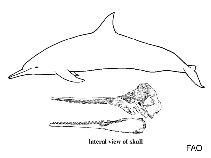Orcaella heinsohni Beasley, Robertson & Arnold, 2005
Australian snubfin dolphinWarning: DOMDocument::load(): SSL operation failed with code 1. OpenSSL Error messages: error:140770FC:SSL routines:SSL23_GET_SERVER_HELLO:unknown protocol in C:\Apache24\htdocs\includes\SpeciesSummary.lib.php on line 1236
Warning: DOMDocument::load(): Failed to enable crypto in C:\Apache24\htdocs\includes\SpeciesSummary.lib.php on line 1236
Warning: DOMDocument::load(https://sealifebase.nrm.se/webservice/AquaMaps/getAMap.php?genus=Orcaella&species=heinsohni): failed to open stream: operation failed in C:\Apache24\htdocs\includes\SpeciesSummary.lib.php on line 1236
Warning: DOMDocument::load(): I/O warning : failed to load external entity "https://sealifebase.nrm.se/webservice/AquaMaps/getAMap.php?genus=Orcaella&species=heinsohni" in C:\Apache24\htdocs\includes\SpeciesSummary.lib.php on line 1236
Envoyez vos Photos
Images Google | No image available for this species;
drawing shows typical species in Delphinidae.
Images Google | No image available for this species;
drawing shows typical species in Delphinidae.
Classification / Names Common names | Synonyms | CoL | ITIS | WoRMS
| Cetartiodactyla | Delphinidae
Environment: milieu / climate zone / depth range / distribution range Écologie
Pélagique; profondeur 0 - 200 m, usually 1 - 10 m. Tropical; 7°S - 90°S, 100°E - 180°E
Distribution Pays | Zones FAO | Écosystèmes | Occurrences | Introductions
Indo-Pacific: Australia and Papua New Guinea.
Length at first maturity / Taille / Poids / Âge
Maturity: Lm ? range ? - ? cm Max length : 270 cm TL mâle / non sexé; (Ref. 78832); 230 cm TL (female)
Description synthétique Morphologie
In lateral view the head is rounded and usually bounded by a distinct neck crease, lacking dorsal groove; mesethmoid plate reduced and generally in advance of the anterior most nasal ossicle, exposing a large area of the frontal bone; presence of supernumerary bone between nasal ossicles and posterior border of mesethmoid; has a greater length of the antiorbital process and a more closely opposed pterygoid hamuli with medial flanges.
Occurs in protected, shallow, coastal waters especially adjacent to river and creek mouths (Ref. 79537).
Life cycle and mating behavior Maturité | Reproduction | Frai | Œufs | Fécondité | Larves
Référence principale
Références | Coordinateur | Collaborateurs
Beasley, I., K.M. Robertson and P. Arnold. 2005. (Ref. 78832)
Statut dans la liste rouge de l'IUCN (Ref. 130435)
Vulnérable, voir Liste Rouge IUCN (VU) (A2cd+3cd+4cd; C2a(i)); Date assessed: 06 June 2017
statut CITES (Ref. 108899)
Appendix I: International trade banned
CMS (Ref. 116361)
Appendix II: Migratory species conserved through agreements
Menace pour l'homme
Harmless
Utilisations par l'homme
FAO - pêcheries: landings | FishSource |
Outils
Plus d'informations
Pays
Zones FAO
Écosystèmes
Occurrences
Introductions
Stocks
Écologie
Régime alimentaire
Éléments du régime alimentaire
Zones FAO
Écosystèmes
Occurrences
Introductions
Stocks
Écologie
Régime alimentaire
Éléments du régime alimentaire
Sources Internet
BHL | BOLD Systems | CISTI | DiscoverLife | FAO(pêcheries: ; publication : search) | Fishipedia | GenBank (genome, nucleotide) | GloBI | Gomexsi | Google Books | Google Scholar | Google | PubMed | Arbre de Vie | Wikipedia (Go, chercher) | Zoological Record
Estimates based on models
Preferred temperature
(Ref. 115969): 26.9 - 28.8, mean 28 (based on 452 cells).



